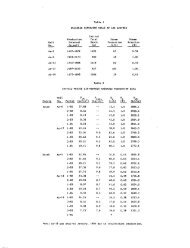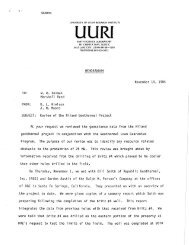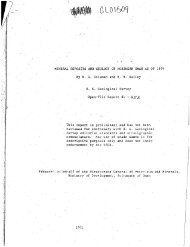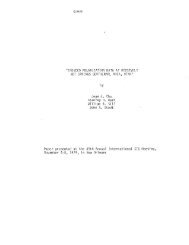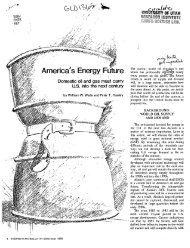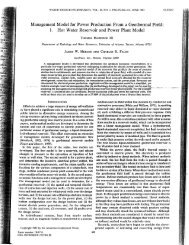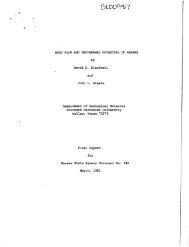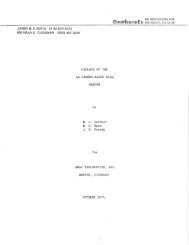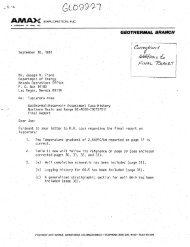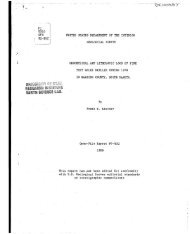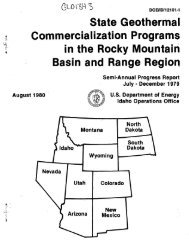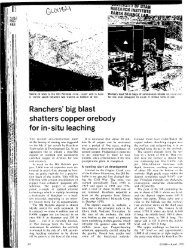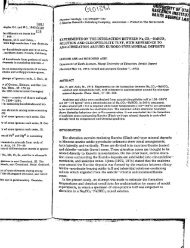Figure I Generalized map of the Wilbur Mining ... - University of Utah
Figure I Generalized map of the Wilbur Mining ... - University of Utah
Figure I Generalized map of the Wilbur Mining ... - University of Utah
Create successful ePaper yourself
Turn your PDF publications into a flip-book with our unique Google optimized e-Paper software.
were thrust eastward over Mesozoic strata during<br />
<strong>the</strong> Sevier orogeny and buried teneath andesites<br />
from a nearby major volcanic center during <strong>the</strong><br />
mid-Tertiary. A major thrust fault, <strong>the</strong> Pavant<br />
thrust, is exposed in <strong>the</strong> Pavant Range north <strong>of</strong> <strong>the</strong><br />
KGRA. Paleozoic rocks in <strong>the</strong> upper plate were<br />
overturned during thrusting and can te seen exposed<br />
above outcrops <strong>of</strong> Jurassic Navajo sandstone<br />
(Crosby, 1959). Volcanism was renewed during <strong>the</strong><br />
Pliocene and Pleistocene with several rhyolitic<br />
eruptions to <strong>the</strong> west in <strong>the</strong> Mineral Range and to<br />
<strong>the</strong> northwest in <strong>the</strong> sou<strong>the</strong>rn Sevier Desert.<br />
The youngest volcanic feature in <strong>the</strong> area is a<br />
Quaternary basaltic cinder cone three miles west <strong>of</strong><br />
<strong>the</strong> area currently teing explored by Union.<br />
A large, shallow <strong>the</strong>nnal gradient anomaly is known<br />
to exist at Cove Fort. Shallow holes drilled by<br />
Union and now available from UURI have tenperatures<br />
<strong>of</strong> up to 119'F at a depth <strong>of</strong> 300 ft. The anonaly<br />
appears to extend several miles to <strong>the</strong> north, v*iere<br />
Hunt Energy drilled a geo<strong>the</strong>rmal test in 1978, and<br />
to <strong>the</strong> northwest in Paleozoic strata in <strong>the</strong> upper<br />
plate <strong>of</strong> <strong>the</strong> Pavant thrust. There have been<br />
reports that deeper temperature holes drilled on<br />
<strong>the</strong> extensions <strong>of</strong> <strong>the</strong> anonaly tecome iso<strong>the</strong>rmal<br />
when <strong>the</strong> water table is encountered at a depth <strong>of</strong><br />
about 1,000 ft. Apparently a large horizontal flow<br />
<strong>of</strong> warm water is taking place at <strong>the</strong> water table in<br />
<strong>the</strong> carbonates.<br />
Exploratory drilling at Cove Fort has found largescale,<br />
secondary porosity and permeability in<br />
dolomites to a depth <strong>of</strong> 5,221 ft. Porosity is<br />
present in <strong>the</strong> form <strong>of</strong> fractures, breccia zones,<br />
zones <strong>of</strong> dolomite sanding and caverns. There may<br />
not yet te enough control to establish <strong>the</strong> continuity<br />
<strong>of</strong> major fractures or <strong>the</strong> role <strong>of</strong> folding in<br />
<strong>the</strong> creation <strong>of</strong> secondary porosity. Water appears<br />
to descend rapidly to depth along some structures,<br />
te heated, and <strong>the</strong>n return to shallow depths along<br />
o<strong>the</strong>r structures where it spreads out laterally in<br />
permeable carbonates creating a large <strong>the</strong>rmal<br />
gradient anomaly. This is basically <strong>the</strong> model<br />
proposed by Morris (1968) for Tintic. The structures<br />
associated with water movement at Cove Port<br />
appear to te similar to those found at Tintic and<br />
it is likely that additional drilling and subsurface<br />
geology at Cove Fort will fur<strong>the</strong>r add to <strong>the</strong><br />
similarities tetween <strong>the</strong> two areas. The mciximura<br />
tenperature found at Cove Fort to date is about<br />
350'F in a contact metamorphic marble near <strong>the</strong>'<br />
bottom <strong>of</strong> <strong>the</strong> 7,735 ft well. A weak flow <strong>of</strong> 43,000<br />
Ibs/hr was produced frcm this zone during a flow<br />
test. The temperatures and pressures associated<br />
with ore deposition at Tintic are telieved to have<br />
been greater than those yet found at Cove Fort<br />
but were probably similar to those found in o<strong>the</strong>r<br />
geo<strong>the</strong>rmal fields. The problem at Cove Fort<br />
appears to te that <strong>the</strong> carbonates are too porous<br />
and permeable,' allowing rapid convection and an<br />
early cooling <strong>of</strong> <strong>the</strong> deep reservoir.<br />
BEX3WAWE AND CARLIN<br />
All <strong>of</strong> <strong>the</strong> productive wells drilled at <strong>the</strong> Beowawe<br />
KGRA prior to 1974 were completed in an area <strong>of</strong><br />
fault intersections near <strong>the</strong> Beowawe Geysers.<br />
These wells bottomed in ei<strong>the</strong>r Tertiary basalts ard<br />
andesites or underlying siliceous rocks <strong>of</strong> <strong>the</strong><br />
183<br />
Edmiston<br />
Western Assemblage assigned to <strong>the</strong> Valmy Formation<br />
(Ordovician). In early 1974, Chevron drilled a<br />
9,551 ft test which was designed to intersect <strong>the</strong><br />
Roterts Mountains thrust near its intersection with<br />
<strong>the</strong> Malpais fault. This well, <strong>the</strong> Chevror>-ATR-Ginn<br />
No.1-13, encountered two lost circulation zones<br />
near TD and was believed to have bottomed in a<br />
fault zone. A successful drill stem test was<br />
conducted. Geologists familiar with Beowawe<br />
have since debated whe<strong>the</strong>r <strong>the</strong> well intersected <strong>the</strong><br />
Malpais fault zone or fractures related to <strong>the</strong><br />
Roterts Mountains thrust. Some geologists have<br />
also questioned <strong>the</strong> reservoir potential <strong>of</strong> <strong>the</strong><br />
underlying cartonates. The Carlin gold deposit,<br />
located 28 miles nor<strong>the</strong>ast <strong>of</strong> Beowawe, can te used<br />
as an exploration model to gain insight into <strong>the</strong><br />
geology <strong>of</strong> <strong>the</strong> geo<strong>the</strong>rmal reservoir at Beowawe.<br />
At Carlin, microscopic disseminations <strong>of</strong> gold are<br />
found in altered dolomites <strong>of</strong> <strong>the</strong> Roterts Mountains<br />
Formation (Silurian) in a window <strong>of</strong> <strong>the</strong><br />
Roterts Mountains thrust. The Roterts Mountains<br />
is variously included in ei<strong>the</strong>r <strong>the</strong> Eastern<br />
(Carbonate) Assanblage or <strong>the</strong> Transitional Assanblage<br />
in <strong>the</strong> geologic literature <strong>of</strong> <strong>the</strong> region.<br />
The geologic section above <strong>the</strong> ore deposit is<br />
reconstructed in <strong>Figure</strong> 3 which is based on a<br />
figure from Hausen and Kerr. Hausen and Kerr state<br />
that penneable horizons in <strong>the</strong> Roterts Mountains<br />
Formation provided a favorable environment for<br />
mineralizing solutions which had travelled up high<br />
angle normal faults ard which subsequently leached<br />
calcite and deposited clay minerals and silica.<br />
Noble and Radtke (1978) state that <strong>the</strong> temperature<br />
<strong>of</strong> <strong>the</strong> fluids was 175*-225*C. Unconformably<br />
overlying <strong>the</strong> ore horizon in <strong>the</strong> mine area is <strong>the</strong><br />
Popovich Formation (Devonian) which is a gray<br />
fossiliferous, medium bedded, locally dolomitic and<br />
silty limestone. Hydro<strong>the</strong>nnal fluids invaded <strong>the</strong><br />
Popovich along its base and along joints and<br />
fractures with subsequent calcite leaching and<br />
silica deposition, but <strong>the</strong> fabric <strong>of</strong> <strong>the</strong> rock was<br />
not totally, altered and it is not an important<br />
ore host.<br />
The Itoterts Mountains thrust separates <strong>the</strong> Popovich<br />
from <strong>the</strong> overlying Vinini Fonnation <strong>of</strong> <strong>the</strong> Western<br />
Assemblage which was thrust eastward into its<br />
present position. Hausen and Kerr state that <strong>the</strong><br />
thrust is about 10 to 20 ft thick and consists <strong>of</strong><br />
bleached, brecciated and iron stained rock rubble.<br />
Cartonate minerals have been leached from <strong>the</strong> fault<br />
zone and frcm adjacent beds telow <strong>the</strong> thrust. They<br />
conclude, and Noble concurs, that <strong>the</strong> thrust plane,<br />
although not an important structure in <strong>the</strong> localization<br />
<strong>of</strong> ore, did serve as a conduit for migrating<br />
solutions over a long period <strong>of</strong> time. The Vinini<br />
Fonnation at Carlin consists <strong>of</strong> siliceous shales.<br />
In o<strong>the</strong>r areas <strong>the</strong> Vinini usually contains minor<br />
quartzites and limestones. Following <strong>the</strong> main<br />
period <strong>of</strong> hydro<strong>the</strong>nnal activity <strong>the</strong>re occurred a<br />
later stage <strong>of</strong> acid leaching related to boiling<br />
<strong>of</strong> <strong>the</strong> fluids as at Cove Ftirt arxJ Tintic (Noble<br />
and Radtke, 1978). This resulted in <strong>the</strong> leaching<br />
<strong>of</strong> dolomite as well as calcite, intense argillic<br />
alteration, and precipitation <strong>of</strong> quartz in <strong>the</strong><br />
shallower part <strong>of</strong> <strong>the</strong> alteration zone. Details <strong>of</strong><br />
<strong>the</strong> origin <strong>of</strong> <strong>the</strong> Carlin deposit are given in a<br />
paper by Radtlce, Rye and Dickson (in press). The<br />
leaching <strong>of</strong> calcite at high temperatures has been



